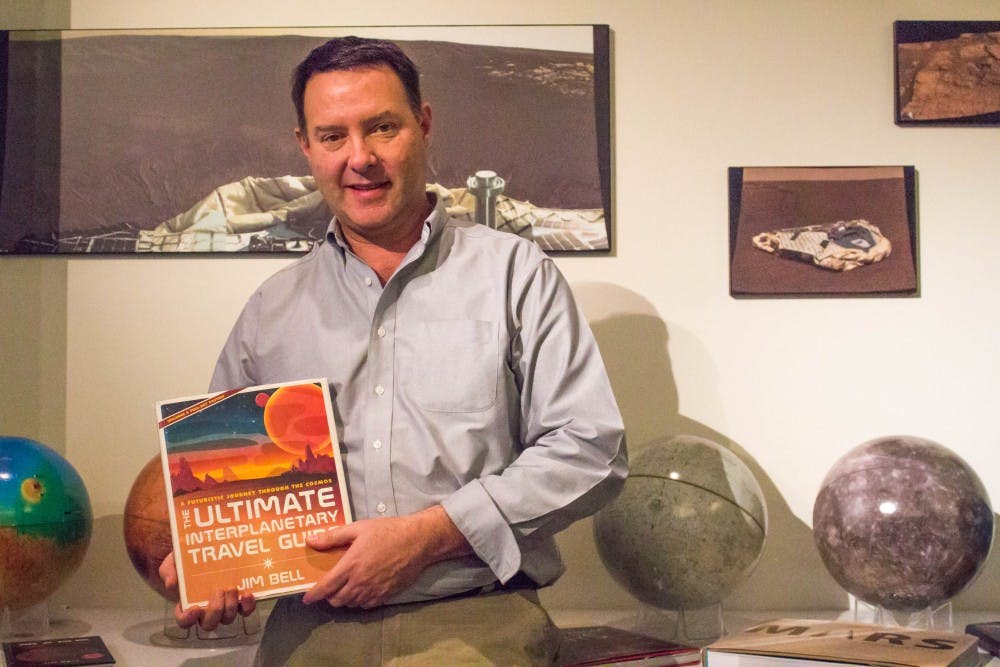When Jules Verne conceptualized space exploration in his 1865 novel "From the Earth to the Moon," it would have seemed fantastical at best to assume that his idea could ever be realized. At that point, humans hadn’t even successfully taken flight within earth's atmosphere.
Artists, including George Melies with his 1902 film "A Trip to the Moon," created snapshots of science fiction and popular wonderment about the unknown in each piece.
A century later, students and professors at ASU are doing the same through art inspired by both real and hypothetical examples of space travel.
Jim Bell, a professor in the School of Earth and Space Exploration, said there's a valuable relationship between art and science.
Drawing upon knowledge from his background in planetary geoscience and his experience as an educator, author and public speaker, Bell’s latest popular science book ‘The Ultimate Interplanetary Travel Guide: A Futuristic Journey Through the Cosmos,’ is premised 200 years in the future when space tourism has become a reality.
Formatted like a travel guide, the book hits on all of the most popular hypothetical travel destinations with recommendations and pictures to supplement the descriptions that are largely based in real scientific and technological possibilities.
Despite the heavy basis in science, the guide was written to be an approachable and fun book for a general audience.
“It is not technical, but I think I was able to sneak in some science for the general audience.”
The Psyche Inspired program, which was piloted in the 2017-2018 school year at ASU but will soon expand to other universities, brings students from every major together in a collaborative, artistic endeavor to capture all of the emotions and science behind NASA’s upcoming Psyche mission.
Psyche is the name of the metal-cored asteroid orbiting the Sun between Mars and Jupiter, and ASU is leading the NASA mission to visit the asteroid in the summer of 2022.
After a competitive selection process, 13 students from majors ranging from ceramics to astronomy were selected to create pieces that reflect all aspects of the mission using a variety of media.
All of their work is on display in Noble Library and will be showcased at an April 4 gallery opening in the Interdisciplinary Science and Technology IV building.
Some of the pieces help explain the scientific and technological elements of the mission while others capture the feelings of those involved as the launch date draws near.
Nikka Bacalzo, graphic design junior, has created five pieces including a pop-up book and work that uses techniques such stop motion animation and paper quilling.
Despite having little initial knowledge of space exploration and and no experience with video editing software prior to Psyche, Bacalzo said she created a stop-motion video to help visualize the mission in more approachable terms.
“I wanted to create a visual of what is happening on the mission and where the spacecraft is traveling to,” Bacalzo said.
The music used in the stop motion was created by another student in the Psyche program, Isaac Wisdom, a freshman music and electrical engineering double major.
Wisdom said ‘Ideas’, the title of the composition, was inspired by the emotions of the group of people in charge of the mission when they first began to dream up its possibility.
“I tried to capture the excitement when someone has a new idea and they know something unique is happening — they are excited to share it with other people and new ideas are thrown back and forth and everyone is playing off of each other,” Wisdom said.
The opportunity to explore scientific themes helps to bridge gaps between the scientific community and the general public.
“A big part of the success of space travel is that people have to care,” Wisdom said. “It might be hard for scientists to explain why people should be excited about what is going on, but having the scientists work with artists and for the artists to make art based on what the scientists are telling them makes it a lot easier for the general public to connect with (them)."
Brooke Owen, the student manager of Psyche and biology junior, said the artwork makes space exploration much more approachable.
“Most people don’t understand a neutron spectrometer, but if you make a (ceramic) glaze that uses the same chemical process it helps people understand that it just has a crazy name and isn’t as terrifying as it sounds,” Owen said.
The Psyche program serves as evidence of the importance of the relationship between artists and scientists.
“It has been really cool because I’ve been learning that in space exploration it doesn’t just take aerospace engineers or planetary scientists — it takes a lot of different people to make a mission successful,” Owen said.
Reach the reporter at goldham@asu.edu and follow @graceoldham123 on Twitter.
Like The State Press on Facebook and follow @statepress on Twitter.




